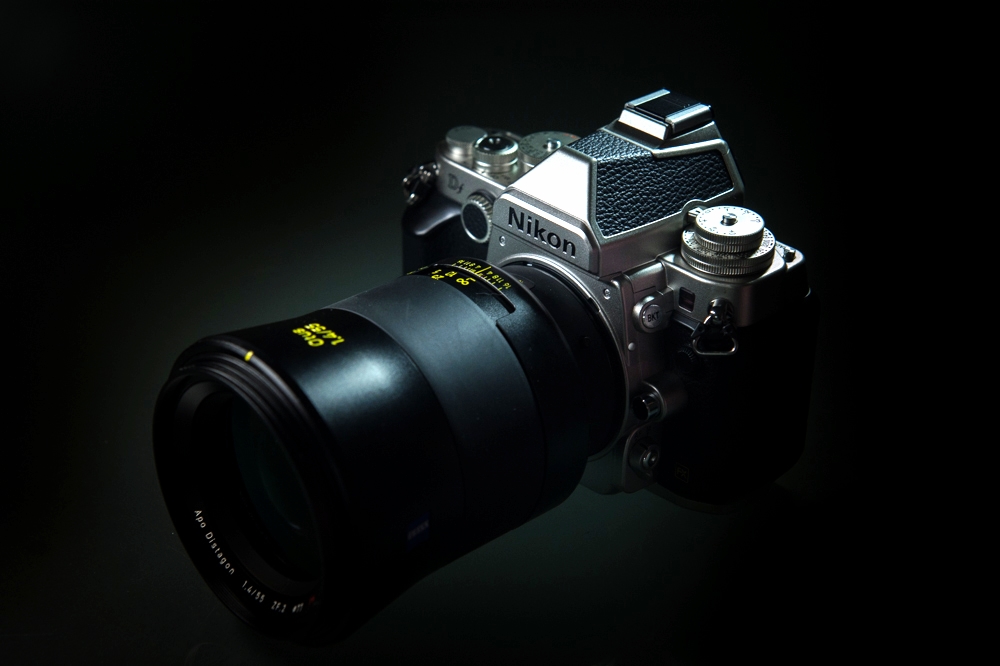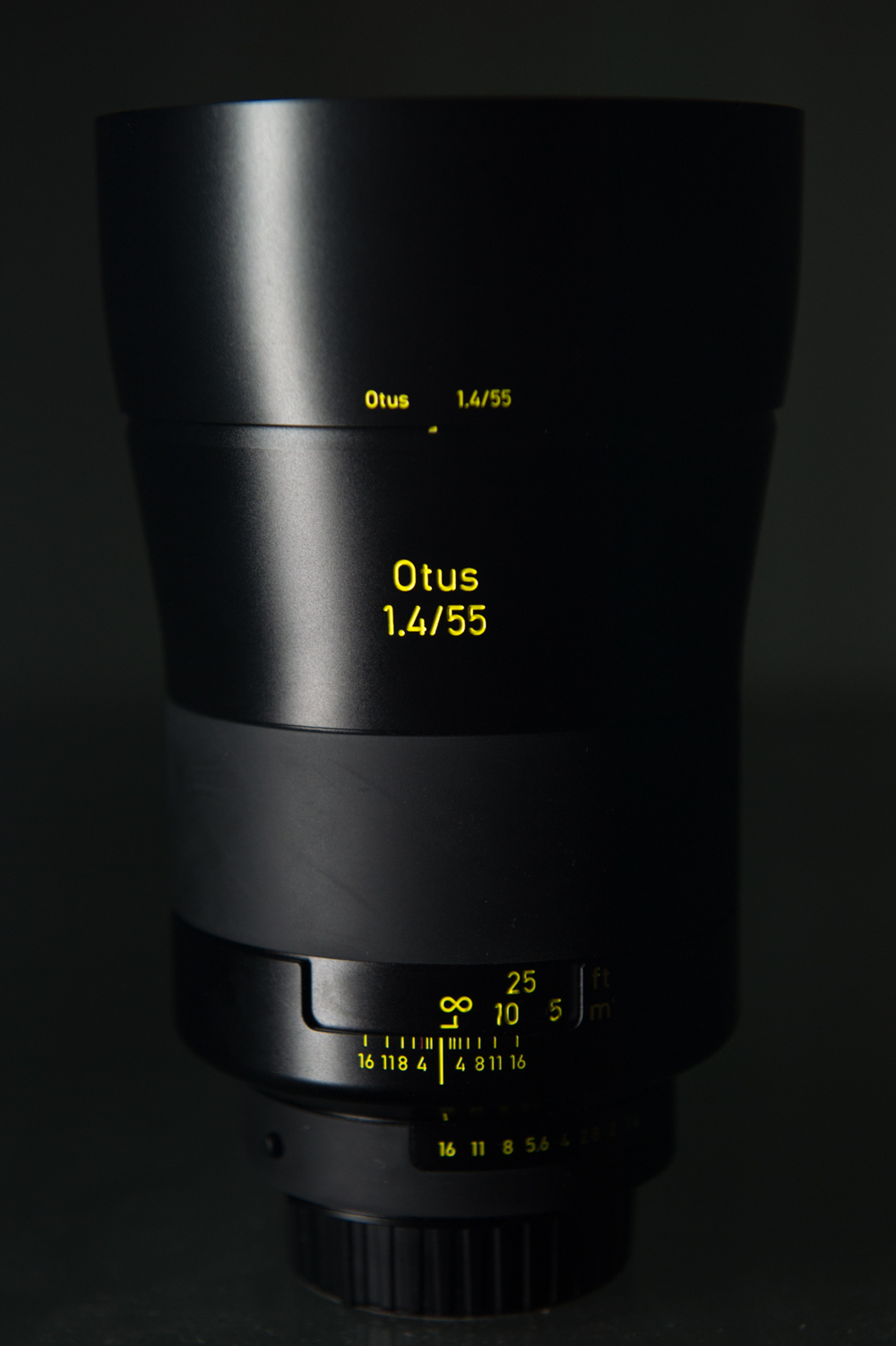You know the saying “Be careful what you wish for, because you might just get it”…..well Zeiss listened and delivered…in size!
Enter the Zeiss Otus. A 55mm lens with a f/1.4 maximum aperture designed with next to no compromises. Many would mention price, which sounds high, but trust me, this lens is actually a bargain at it’s US$4,000 price – but more on that later. Here is some basic information about this lens.
- The Otus is a fully manual focusing lens
- a completely new design, both optically and mechanically 12 lenses in 10 groups
- One doubled sided aspherical lens and six lenses made of extremely rare glass that are more valuable than gold ….hmm
- Available in Nikon ZF.2 and Canon ZE mounts
- 77mm filter thread
- Close focusing at 50cm
- Long focus throw of 248 degrees
- Yellow font markings are taken from the Cine line of lenses and are designed to be clearly visible in low light.
Zeiss Otus details
Zeiss is no stranger to manufacturing the highest quality lenses, but as of recently with the success of Leica's digital M and S lines, Leica have been the company to look out for in regards to ultimate resolution on 35mm cameras. Their wide selection of super high resolution lenses for use on their rangefinder M cameras is unmatched by most competing brands in the 35mm photography segment. This year they released the Apo-Summicron 50/2 lens which at around US$8,0000, brought Leica users the ultimate 50mm lens from a technical quality standpoint…and they did it in a tiny compact lens that's half the size of most 50mm f/1.8 lenses on SLR cameras.
From a technical standpoint, the goals of most lens manufacturers usually covers:
Zeiss Otus lens with hood
- Ultimate lens resolution from maximum aperture, consistently through the aperture range.
- As little distortion as possible
- As little field curvature as possible (except for certain lenses like the Noct)
- Flare/internal reflections resistance
- Consistent contrast performance, especially against strong light sources.
…..the inception of digital has also brought about other design parameters including cutting chromatic aberrations and fringing. There are other goals and parameters but I don’t have all day to list them all, and I’m a photographer, not a scientist.
The name Otus is latin and refers to a group of owls known for having excellent night vision - so it’s not named after a lens designer’s pet dog. Looking at the Otus, the first thing you notice is just how large it is. It looks like a medium format lens in a very modern body that is similar in size to a 24-70mm f/2.8 pro zoom lens. For a standard 55mm lens, it’s the largest of them all. So why would Zeiss make this now, and why start with a 55mm focal length?
Firstly, the market is ready for it. Years ago, we never looked at our images in such detail. With film we were very content with the quality of the lenses available to match the quality required from 35mm negative and transparency film. These days, we scrutinize our pictures like never before. The market is super demanding, and no less demanding than the high resolution sensors being made, but without lenses capable of taking full advantage – until now. Like any good relationship, a lens design is made up of compromises. The two main compromises being size and price. The 55mm focal length is close in line with the most popular fixed focal length lens in the world – the 50mm. As popular and useful as the 50mm lens is, it has never met the qualities of the 85mm focal length or longer, especially wide open in 1.4 versions. Some standouts have come close, with the next best thing being the Leica Summilux 50/1.4 ASPH, which is also an APO designed lens.
Zeiss Otus details
So by now you’re wondering how it performs right? Well mounted on the new Nikon Df, I took to the streets of Melbourne to see just how good this lens really is. Simply put, I was stunned, shocked and super excited. Just viewing the pictures on the back of the camera, you can immediately see the fruits of its new design. I started off doing a quick few snaps into the sun and was happy to see there was no flare and no internal reflections (no UV or protection filter used).











Zeiss Otus on Nikon Df at f/1.4
300% crop
Nikon Df and Zeiss Otus shot at f/1.4
100% crop
As I began to start shooting my fears were coming true. This lens is showing signs that it delivers 100% on sharpness at f/1.4. Not only that, it's sharpness is bitingly sharp. You've heard the description 'tack sharp' used on photography forums no doubt, and usually when I hear it, I am skeptical because there aren't many lenses that i'd describe as tack sharp at f/1.4. Maybe the impression of tack sharp is there because of the sharp fall-off from focus to defocus, but certainly for a lens to be 'tack sharp' at f1/.4, it now needs to match the Zeiss Otus!'
After the sharpness hits you, the bokeh draws you in. It's about as silky smooth as I've ever seen from just about any lens, especially a standard lens from 50-60mm. The previous bokeh king was the Leica Summilux 50/1.4 ASPH, which produces amazingly beautiful out of focus areas with a very smooth transition from focus to defocus. Like the Summilux, the Otus is super smooth, and very painterly in effect, without it looking like an effect, so to speak. The difference between the two lenses is the immediate bite and sharp fall off right after the focus point. This occurs almost like a Noct lens, which is very unique for a f/1.4 lens.
Nikon Df and Zeiss Otus shot at f/1.4
Nikon Df and Zeiss Otus shot at f/1.4
100% crop
100% crop
Lens Signature
Every lens has it’s own signature, or drawing style, which is mostly evident when looking at it's bokeh and sharpness structure. It’s no secret that the Otus is attempting to draw better than any lens ever made for 35mm photography, especially in the 50mm group. The reigning champion in this category would be the Leica Summilux-M 50/1.4 ASPH lens, along side the Hexanon 60/1.2 II – both lenses in Leica M mount. The Summilux especially was Leica’s standard by which most if not all 50mm lenses could be judged and rightfully so. It has excellent sharpness at f/1.4 and the smoothest bokeh ever seen on a standard lens at f/1.4. The only issue is that due to field curvature and size, the sharpness wide open was very hard to achieve off-center. This is the most common issue in lens design and while it does make focus and recomposing difficult, it does present the user with a more pronounced bokeh and sharp falloff towards the sides of the frame which many users like.
Nikon Df with Zeis Otus at f/1.4
Nikon Df with Zeiss Otus shot at f/1.4
With the Otus, field curvature has been reduced, allowing the photographer to more easily focus and recompose. Being an SLR lens, it’s also possible to focus without recomposing, unless you’re intending to use this lens on a mirrrorless camera like the Leica M, which requires your to use focus assist only in the center. The flat field nature of this lens also works well for landscapes at large apertures as well as closer range work.
Zeiss Otus at close focus of 50cm at f/1.4
100% crop
Zeiss Otus at close focus of 50cm at f/1.4
100% crop
Looking at the bokeh of the Otus, I can say it’s something I’ve never seen before. It looks like the bokeh of an 85mm lens built into a 50mm perspective - incredible! It’s so smooth and natural looking, it resembles the closest thing to defocusing my own eyes. Its simply amazing, as it draws in such fine detail. This lens just does everything right…..or does it? .......I did manage to achieve a little flare but it's very reasonable considering the super strong sunset I was shooting against at f/1.4.
Nikon Df with Zeiss Otus at f/1.4
Handling
Walking around with this lens can be troublesome if you're not used to carrying larger, heavier equipment. I won't tip-toe around it's size and weight, but whether it bothers you or not depends on how much you value it's performance. Focusing is completely manual and very smooth with a decent focus throw to help achieve accurate focusing. I used the focus assist feature with the Nikon Df and it helped a lot. To use it properly you need to use it as a guide only, then depending on your eyes it won't hurt to take a few frames using the focus bracket technique where you either shift your body every so slightly forwards or backwards, or move focus in the same fashion. This is by no means an easy thing to do, but being a lover of manual focusing I see it being well worth the effort, especially for portraits or landscapes. If you're planning on using this as a street lens for quick grab shots at f/1.4, forget it! Though if you're planning on using the focusing scale for hyper focal shooting, you may have more luck.
Focusing scale
This is the one weakness in design that I can see on the Otus. There is no focusing window so the scale is exposed, leaving an extra point for dust and moisture to enter. I haven't owned this lens long enough to foresee it being an issue, but it's a very slight concern.
Build quality is most certainly at the highest level, coming very close to the Leica S range, which says a lot considering the price and quality of those medium format lenses. The rubber focusing ring is very comfortable and grippy, but can be a little hard to locate when handling the lens in the beginning. Aperture ring clicks are solid and pronounced without feeling cheap, and the lens hood attaches firmly and blends well with the lens as if it's one piece.
Nikon Df with Ziess Otus at f/1.4
100% crop
Nikon Df with Ziess Otus at f/1.4
Nikon Df with Zeiss Otus at 1.4
100% crop
Nikon Df with Ziess Otus at f/1.4
Last thoughts on first impressions
The Zeiss Otus truly delivers in every way, and is as close to being a perfect lens as I've ever come across, and trust me, I've tried them all! I really would like to make one thing very clear. I am very rarely impressed with lenses anymore. I've grown tired of all the testing and fault finding. We can become overly critical of lenses, and rightfully so. We pay good money for the best and we want perfection, but never get it. Well I am proud to say that this lens is worth every cent it costs and even then it's still a bargain. If you're familiar with the quality of certain medium format lenses, you know what can be achieved when compromises are thrown out the door.
Zeiss has taken 35mm lenses into a new domain, a new planet. It's no wonder professional reviewers like DXOMark and Roger Cicala of LensRentals.com also rave about this lens in a similar fashion. I am particularly interested to see Steve Huff has to say about this lens when he releases his full review. If you're willing to pay for the best pixel peeping information, Lloyd Chambers offers the very best service in this area.
Lastly I would like to thank Zeiss for taking the bold step forward and creating this lens. It's about time a manufacturer stood up in the 35mm SLR world and made a lens more than capable and worthy of today's high resolution sensors. Zeiss has truly taken lens design to the next level and shown us what can be accomplished if we sacrifice the usual compromises for ultimate imaging quality.
>>> All images shot in Nikon NEF RAW format and converted using Nikon Capture NX2 software as Lightroom compatibility is not yet available. No sharpening was added and I expect better results in Lightroom.















































